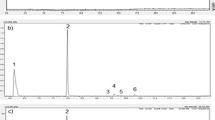Abstract
Volatile components of all the excretory products deposited by house mice may contribute to their ability to identify their own territories. When mice were placed on a clean surface, they deposited feces, secretions discharged from the anus (anal secretion) and urine. Exposure to several clean surfaces in succession caused a decline in the number of fecal pellets and urine spots deposited and an increase in the number of anal smears. The volatile compounds emanating from feces and anal secretion appeared to be qualitatively and quantitatively different from those emanating from urine, but many compounds with short retention times appeared to be common to feces and anal secretion. Introducing volatiles from feces of strange males into the territory of a singly housed male altered the site at which the resident animal deposited its feces but had no effect on the site at which it urinated. Introducing the feces or the anal secretion of a male mouse into the environment where it encountered a strange conspecific appeared to improve its success in encounters with a conspecific. It was concluded that at least some of the volatile compounds that enable mice to distinguish their own territory from those of neighboring groups may be derived from feces and that many fecal volatiles may originate from the secretions of glands opening into the digestive tract.
Similar content being viewed by others
References
Archer, J. 1975. Rodent sex differences in emotional and related behavior.Behav. Biol. 14:451- 479.
Brown, R.E. 1985. The rodents II: suborder Myomorpha, pp. 345–457,in R.E. Brown and D.W. Macdonald (eds.). Social Odours in Mammals, Vol. 1, Clarendon Press, Oxford.
Cox, T.P. 1984. Ethological isolation between local populations of house mice (Mus musculus) based on olfaction.Anim. Behav. 32:1068–1077.
Crowcroft, P. 1955. Territoriality in wild house mice,Mus musculus, J. Mammal. 36:299–301.
Crowcroft, P., andRowe, F.P. 1963. Social organization and territorial behaviour in the wild house mouse (Mus musculus L.).Proc Zool. Soc. London 140:517–531.
Desjardins, C., Maruniak, J.A., andBronson, F.H. 1973. Social rank in house mice: Differentiation revealed by ultraviolet visualization of urinary marking patterns.Science 182:939- 941.
Feigl, F. 1966. Spot Tests in Organic Analysis, 7th ed. Elsevier Scientific, Amsterdam.
Goodrich, B.S., Hesterman, E.R., Murray, K.E., Mykytowycz, R., Stanley, G., andSugowdz, G. 1978. Identification of behaviorally significant compounds in the anal gland of the rabbit,Oryctolagus cuniculus.J. Chem. Ecol. 4:581–594.
Goodrich, B.S., Hesterman, E.R., Shaw, K.S., andMykytowycz, R. 1981. Identification of some volatile compounds in the odor of fecal pellets of rabbit,Oryctolagus cuniculus.J. Chem Ecol. 7:813–823.
Goodrich, B.S., Gambale, S., Pennycuik, P.R. andRedhead, T.D. 1990. Volatiles from feces of wild male house mice: Chemistry and effects on behavior and heart rate.J. Chem. Ecol. 16:2091–2106.
Harrington, I.E. 1976. Recognition of territorial boundaries by olfactory cues in mice (Mus musculus L.)Z. Tierpsychol. 41:295–306.
Hurst, J.L. 1987. The function of urine marking in a free-living population of house mice,Mus domesticus Rutty.Anim. Behav. 35:1433–1442.
Jones, R.B., andNowell, N.W. 1973a. The effect of urine on the investigatory behavior of male albino mice.Physiol. Behav. 11:35–38.
Jones, R.B., andNowell, N.W. 1973b. Aversion and aggression-promoting properties of urine from dominant and subordinate male mice.Anim. Learn. Behav. 1:207–210.
Jones, R.B., andNowell, N.W. 1977. Aversive potency of male mouse urine: A temporal study.Behav. Biol. 19:523–526.
Mackintosh, J.H. 1973. Factors affecting the recognition of territorial boundaries by mice (Mus musculus).Anim. Behav. 21:464–470.
Mackintosh, J.H., andGrant, E.C. 1966. The effect of olfactory stimuli on the agonistic behaviour of laboratory mice.Z. Tierpsychol. 23:584–587.
Mugford, R.A., andNowell, N.W. 1970. Pheromones and their effect on aggression in mice.Nature 226:967–968.
Pennycuik, P.R. 1973. Behaviour of mice housed in groups at 4, 21 and 33°C.Aust. J. Biol. Sci. 26:917–926.
Reimer, J.D., andPetras, M.L. 1967. Breeding structure of the house mouse,Mus musculus, in population cage.J. Mammal. 48:88–99.
Schwende, F.J., Wiesler, D., Jorgenson, J.W., Carmack, M., andNovotny, M. 1986. Urinary volatile constituents of the house mouse,Mus musculus, and their endocrine dependency.J. Chem. Ecol. 12:277–296.
Singleton, G.R., andHay, D.A. 1983. The effect of social organization on reproductive success and gene flow in colonies of wild house mice,Mus musculus, Behav.Ecol. Sociobiol. 12:49- 56.
Welch, J.F. 1953. Formation of urinating “posts” by house mice (Mus) held under restricted conditions.J. Mammal. 34:502–503.
Author information
Authors and Affiliations
Rights and permissions
About this article
Cite this article
Goodrich, B.S., Gambale, S., Penncuik, P.R. et al. Volatile compounds from excreta of laboratory mice (Mus musculus). J Chem Ecol 16, 2107–2120 (1990). https://doi.org/10.1007/BF01026923
Received:
Accepted:
Issue Date:
DOI: https://doi.org/10.1007/BF01026923




